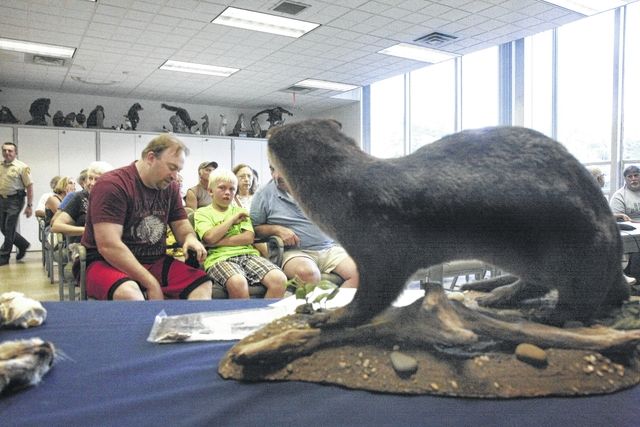Click here to subscribe today or Login.
To see one is rare, but that doesn’t mean they don’t exist.
River otters have made a comeback in the state, and last week the Pennsylvania Game Commission welcomed a full house to its Northeast Region Office to tell people about the aquatic mammals and their plans for a limited trapping season.
Tom Hardisky, the agency’s aquatic furbearer biologist, said otters are nocturnal, which makes them a rare sight. Hardisky said he sees about one a year, and that’s a lot more than decades ago.
“Industrial waste, acid mine drainage and pollution from tanneries wiped out the otter’s prey species which is fish,” Hardisky said. “By 1977, they existed just on the western edge of the state and in the northeast.”
Otters, which are members of the weasel family and can weigh up to 20 pounds, feed primarily on suckers, chubs, sunfish and stocked trout. Hardisky said they’ll also consume crayfish, turtles and snakes.
As regulations resulted in cleaner water over the years, those prey species increased and so did otters.
The Game Commission released 153 otters throughout the state from 1982 to 2004. By 1998, Hardisky said, otters established populations in watersheds across Pennsylvania and the northeast remains a stronghold.
“In our neck of the woods, things look pretty good,” Hardisky said. “We always had river otters in the northeast and the Poconos and, as of 2014, there was a huge range expansion.”
Due to a combination of the rise of incidental captures by beaver trappers, damage complaints and the fact that all but two other states in the East (Rhode Island and Indiana) don’t have an otter trapping season, Hardisky said, the Game Commission has decided to hold a limited season in 2016.
Hardisky said other states that have otter trapping seasons, such as New York with an average annual harvest of 1,270, have proven a regulated harvest won’t harm the population.
“It comes back year after year,” he said. “But we want to do this very conservatively.”
Pennsylvania’s season will run for three days – Feb. 21-23 and has a capped harvest of 85. The season can be extended for five days, but once that quota of 85 is reached it will be shut down.
By holding the season in February, Hardisky said, it will reduce the chance of pregnant females being harvested.
“This is the time of year when males are most active so they would be most vulnerable, as compared to females, to trapping activity,” Hardisky said.
All otter harvests must be reported to the Game Commission within 24 hours and Hardisky said the data will yield a lot of useful data for the agency, such as age structure, reproductive status, habitat and overall health.
The otter trapping season will take place in Wildlife Management Units 3C and 3D only, and Hardisky said it could expand to the northwest region next.
But for now, the Game Commission will wait and see how the 2016 season plays out before deciding on any expansion.
“We want to safeguard the population,” Hardisky said. “This season is highly regulated and we’re confident we’re not going to overdo it.”





